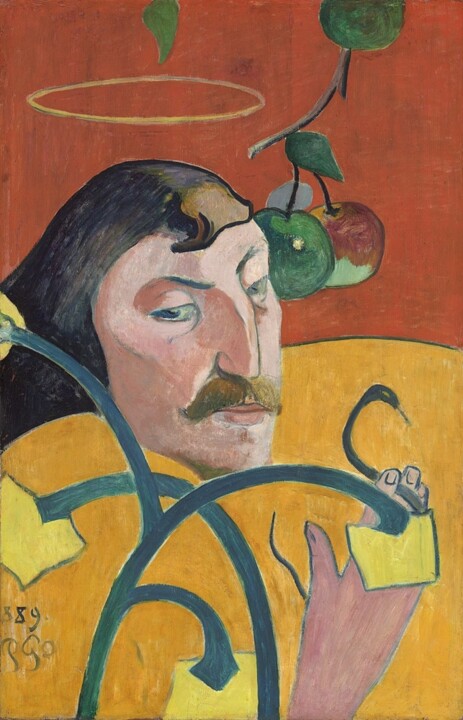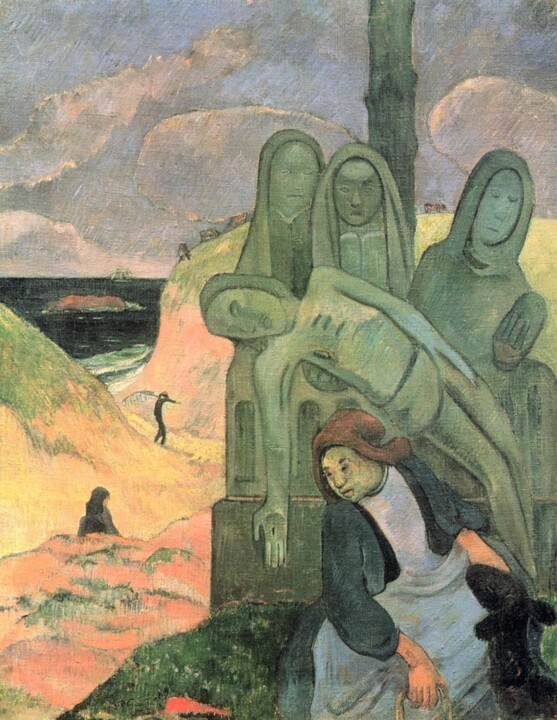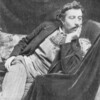 Paul Gauguin, Self-Portrait with Halo and Snake, 1889. Oil painting on wood, 79 cm × 51 cm. Washington, D.C: National Gallery of Art.
Paul Gauguin, Self-Portrait with Halo and Snake, 1889. Oil painting on wood, 79 cm × 51 cm. Washington, D.C: National Gallery of Art.
Who was Paul Gauguin?
Paul Gauguin (1848-1903) was a French painter and printmaker who is now recognized as one of the most influential artists of the late 19th and early 20th centuries. He is known for his experimental use of color, his primitivist style, and his depictions of life in Tahiti and other parts of the South Pacific. Gauguin began his career as a stockbroker, but he eventually abandoned this profession to pursue art full-time. He initially painted in a traditional style, but he later became interested in the work of the Impressionists and Post-Impressionists. He was particularly influenced by the use of color and the desire to express emotions in a more direct way. In the 1890s, Gauguin began to travel extensively, eventually settling in Tahiti in 1891. He was fascinated by the culture and traditions of the island, and he sought to capture its beauty and authenticity in his paintings. He also began to experiment with different techniques and mediums, such as woodcuts and ceramics. Despite his artistic success, Gauguin struggled with poverty and ill health for much of his life. He died in 1903 at the age of 54. Today, his work is highly regarded and his influence can be seen in the work of many later artists.
 Paul Gauguin, Tahitian Women on the Beach, 1891. Oil on canvas, 69 cm × 91 cm. Paris: Musée d'Orsay.
Paul Gauguin, Tahitian Women on the Beach, 1891. Oil on canvas, 69 cm × 91 cm. Paris: Musée d'Orsay.
What are the stylistic peculiarities of Paul Gauguin?
Symbolism: Gauguin was one of the leading figures of the Symbolist movement, which emphasized the use of symbols and metaphorical imagery to convey deeper meaning. In his paintings, he often used symbolic motifs, such as Tahitian gods and goddesses, to explore spiritual and mystical themes.
Bold color: Gauguin was known for his use of bright, bold colors, which he used to express emotion and mood. He often used flat areas of color, without any shading or gradation, to create a decorative effect.
Simplified forms: Gauguin's paintings often feature simplified, flattened forms, which he used to emphasize the decorative qualities of his work. He was also interested in non-Western art, such as the art of ancient Egypt and the South Pacific, which influenced his use of simplified forms.
Juxtaposition: Gauguin often juxtaposed different elements in his paintings, such as contrasting colors or patterns, to create visual interest and tension. This technique also allowed him to explore contrasting ideas or themes within his work.
Narrative: Many of Gauguin's paintings tell a story or convey a specific narrative, often based on his experiences living in Tahiti. He was interested in exploring the myths and legends of the South Pacific, as well as the everyday lives of the people he encountered there.
Overall, Gauguin's work is characterized by its bold, decorative style, its use of symbolism and narrative, and its interest in non-Western art and culture.
 Paul Gauguin, Where do we come from? What are we? Where are we going, 1897. Oil on canvas, 139.1×374.5 cm. Boston: Museum of Fine Arts.
Paul Gauguin, Where do we come from? What are we? Where are we going, 1897. Oil on canvas, 139.1×374.5 cm. Boston: Museum of Fine Arts.
What subjects did Paul Gauguin's art deal with?
Tahitian life: One of the most prominent themes in Gauguin's work is his portrayal of Tahitian life. After leaving France in search of a more primitive and authentic way of life, Gauguin spent many years living in Tahiti and depicting the people, landscapes, and culture he encountered there.
Mythology and spirituality: Gauguin was deeply interested in the mythology and spirituality of the South Pacific, and many of his paintings incorporate images of Tahitian gods and goddesses. He was also influenced by his experiences with Catholicism and theosophy, and his work often reflects his spiritual and mystical beliefs.
Intimacy and sensuality: Gauguin's paintings often feature intimate and sensual depictions of women, often with an exoticized or idealized quality. He was criticized during his lifetime for his objectification of women and his colonialist attitudes toward the people of Tahiti.
Still life and interior scenes: In addition to his depictions of Tahitian life, Gauguin also created many still life and interior scenes throughout his career. These paintings often incorporate his interest in symbolism and his love of bright, bold color.
Self-portraits: Gauguin created many self-portraits throughout his career, often using them as a means of exploring his own identity and spiritual beliefs. In these paintings, he often depicts himself in a variety of guises and costumes, reflecting his interest in performance and theater.
 Paul Gauguin, The Yellow Christ, 1889. Oil on canvas, 92×73 cm. Buffalo: Albright-Knox Art Gallery.
Paul Gauguin, The Yellow Christ, 1889. Oil on canvas, 92×73 cm. Buffalo: Albright-Knox Art Gallery.
The Yellow Christ (1889)
The Yellow Christ is a painting by Paul Gauguin, completed in 1889. It is an oil on canvas measuring 91.1 x 73.2 cm, now in the collection of the Albright-Knox Art Gallery in Buffalo, New York. The painting depicts a crucifixion scene, with a yellow-skinned Christ hanging from a brown cross against a landscape background. The figure of Christ is depicted with his head lowered and eyes closed, conveying a sense of suffering and resignation. His body is elongated and distorted, with exaggerated hands and feet, and his skin seems to glow with an otherworldly light. In the foreground, a group of women dressed in traditional Breton costumes kneel in prayer, their faces obscured. In the background, a small group of figures stand in a line, two of them appearing to have faces turned toward the viewer. The painting is notable for its bold use of color: the bright background matches well with the yellow figure of Christ. The use of color also serves to convey a sense of emotion and drama, with the reds suggesting violence and the blues lending calm and serenity. The painting is often interpreted as a symbol of Gauguin's disillusionment with the Catholic Church, which he considered corrupt and hypocritical. He believed that true spirituality could be found in non-Western religions and was deeply influenced by the mythology and spirituality of the South Pacific. Overall, The Yellow Christ is a powerful and emotionally charged work that demonstrates Gauguin's innovative use of color and interest in spiritual and mystical themes. It is considered one of his most significant works and a key example of his post-Impressionist style.
 The Crucifix of Trémalo, Pont-Aven, an anonymous wood sculpture, 189 x 133 cm.
The Crucifix of Trémalo, Pont-Aven, an anonymous wood sculpture, 189 x 133 cm.
Crucifix of TrémaloPont-Aven
There is some evidence to suggest that the Crucifix of Trémalo, located in the town of Pont-Aven, may have inspired Paul Gauguin's Yellow Christ. The crucifix, which depicts Christ with a yellow loincloth, was located in the same church that Gauguin attended while he was living in Pont-Aven in the late 19th century. Gauguin was known to have been influenced by the religious symbolism of the Brittany region, where he lived for a time. The yellow color of the loincloth in the Trémalo crucifix may have caught his attention and influenced his own use of color in his painting of the Yellow Christ. However, it is also worth noting that Gauguin was known to have been inspired by a variety of religious and cultural influences in his art, and the Yellow Christ may have been influenced by multiple sources, including his own imagination. In any case, the connection between the Trémalo crucifix and Gauguin's Yellow Christ remains a topic of debate and interpretation among art historians and scholars.
The context of creation
Paul Gauguin's Yellow Christ was created in the context of his time spent in the town of Pont-Aven, Brittany, France, in the late 19th century. Gauguin was attracted to the traditional culture and religious customs of the region, which he found a rich source of inspiration for his art. The Yellow Christ was painted in 1889 and is considered one of Gauguin's most important works. The use of bright, vivid colors and flattened shapes is characteristic of Gauguin's style, influenced by his experiences in Brittany and his travels to other parts of the world. The Yellow Christ is often interpreted as a symbol of Gauguin's rejection of Western Christianity and his embrace of a more primitive, non-European spirituality. The painting reflects Gauguin's interest in exploring the connections between religion, nature and culture and his belief in the power of art to express profound spiritual truths. Despite its controversial subject matter, Yellow Christ was well received by many of Gauguin's contemporaries and helped solidify his reputation as a leading figure in the emerging Symbolist movement.
 Paul Gauguin, The Green Christ, 1889. Oil painting on wood, 92 cm × 73 cm. , Brussels: Royal Museums of Fine Arts of Belgium.
Paul Gauguin, The Green Christ, 1889. Oil painting on wood, 92 cm × 73 cm. , Brussels: Royal Museums of Fine Arts of Belgium.
Gauguin's The Other Christ
Paul Gauguin's painting "The Green Christ" is a powerful and evocative work of art that embodies the artist's profound spiritual and artistic vision. Painted in 1889 during Gauguin's stay in the small French town of Pont-Aven, the painting depicts the ordeal of the green Christ on a naturalistic background. The image of Christ is depicted with elongated limbs and an almost emaciated body, highlighting the pain and suffering of the crucifixion. The use of the bright green color for the background of the painting is striking and unusual, as it adds a sense of otherworldliness and mystery to the work. The title of the painting, "The Green Christ," has led many to speculate on the symbolism behind the choice of color. Some believe that the color green represents the verdant and natural world, in stark contrast to the suffering of the crucified Christ. Others have suggested that the color green represents the life-giving properties of Christ, who is shown sacrificing himself for the salvation of humanity. In "The Green Christ," Gauguin used simple, flat shapes and sharp outlines to create a stylized, almost primitive depiction of the crucifixion. Overall, "The Green Christ" is a powerful and bewitching work of art that speaks to both Gauguin's artistic genius and his deep spiritual vision.


 Selena Mattei
Selena Mattei








